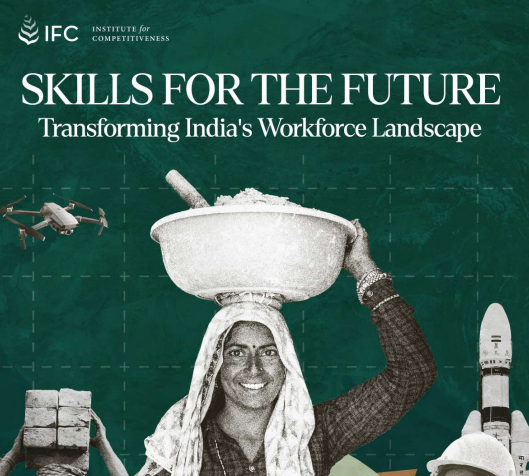Skills for the Future

- 01 Jul 2025
In News:
Recently, theUnion Minister Jayant Chaudhary (MoS, Independent Charge – Ministry of Skill Development and Entrepreneurship, and MoS – Ministry of Education) unveiled the report "Skills for the Future: Transforming India’s Workforce Landscape", prepared by the Institute for Competitiveness (IFC). This data-driven report critically analyses India’s skilling ecosystem using PLFS 2023–24 and other datasets.
Significance of Skilling for India’s Development
- Demographic Dividend: India has one of the world’s youngest populations. Skilling is crucial to leverage this before population ageing sets in (by 2047).
- Economic Growth: A 1% rise in Gross Enrolment Ratio (GER) at the tertiary level increases GDP by 0.511% (Parika, 2020).
- Employment Creation: India needs to create 5 lakh non-farm jobs annually till 2030 (Economic Survey 2023–24).
- Global Competitiveness: Leadership in EVs, AI, biotechnology, and green energy demands a future-ready workforce.
Key Findings from the Report (PLFS 2023–24 Based)
1. Skill Distribution
- 88% of India’s workforce is in low-competency jobs (Skill Levels 1 & 2).
- Only 10–12% are employed in high-skill roles (Skill Levels 3 & 4).
- Only 4.5% of the workforce has received formal vocational training.
2. Education-Skill Mismatch
- Only 8.25% of graduates are in roles matching their skill level.
- Over 50% of graduates are employed in lower-skill jobs.
- Severe case of overqualification and underutilization of educational capital.
3. TVET and Sectoral Gaps
- Top 5 Sectors (66% of vocational enrolment):
- Electronics
- IT & ITeS
- Textiles & Apparel
- Healthcare & Life Sciences
- Beauty & Wellness
- Skill Deficits are critical in high-growth sectors like green tech, AI, biotech, and EVs.
4. Wage Inequality by Skill Level
Skill Level Avg. Annual Wage
Level 1 Rs.98,835
Level 2 Rs.1.26 lakh
Level 3 Rs.2.81 lakh
Level 4 Rs.3.94 lakh
46% of the workforce earns less than ?1 lakh/year, highlighting a major economic disparity.
5. Regional Disparities
- Low-Skilled States: Bihar, Assam (95% in Skill Levels 1 & 2)
- Higher-Skill States: Kerala, Chandigarh
- Migration and brain drain observed in low-skill, low-growth regions
Challenges Identified
- Skill-Education Mismatch: Graduates in low-skill jobs; vocational roles filled by underqualified informal workers.
- Weak TVET-Industry Linkage: Existing courses not aligned with Industry 4.0 or green economy needs.
- Low GER and Transition Dropout: Higher secondary GER at 57.56%, tertiary GER still below 30%.
- Gender & Social Exclusion: Low skilling access for women, SC/STs, rural youth.
- Data & Outcome Gaps: No central skill repository or real-time job-skill tracking.
Recommendations from the Report
- Institutional Reforms
- Launch a National Skill Gap Survey
- Establish a Central Skill Data Repository for real-time, evidence-based policymaking
- Curriculum & TVET Overhaul
- Update NCO codes (National Classification of Occupations)
- Integrate vocational training in schools
- Scale up PMKVY, NAPS, and credit-linked certifications
- Industry & Market Linkages
- Incentivise hiring of certified skilled labour
- Link industry wage structures to skill certifications
- Encourage industry-led training programs
- Targeted Inclusion & Regional Empowerment
- Empower State Skill Missions
- Prioritise high-potential regions and sectors
- Target women, SC/STs, informal sector workers
- Education Pipeline Strengthening
- Raise GER at higher secondary and tertiary levels
- Promote flexible, modular skilling programs for working populations and school dropouts
